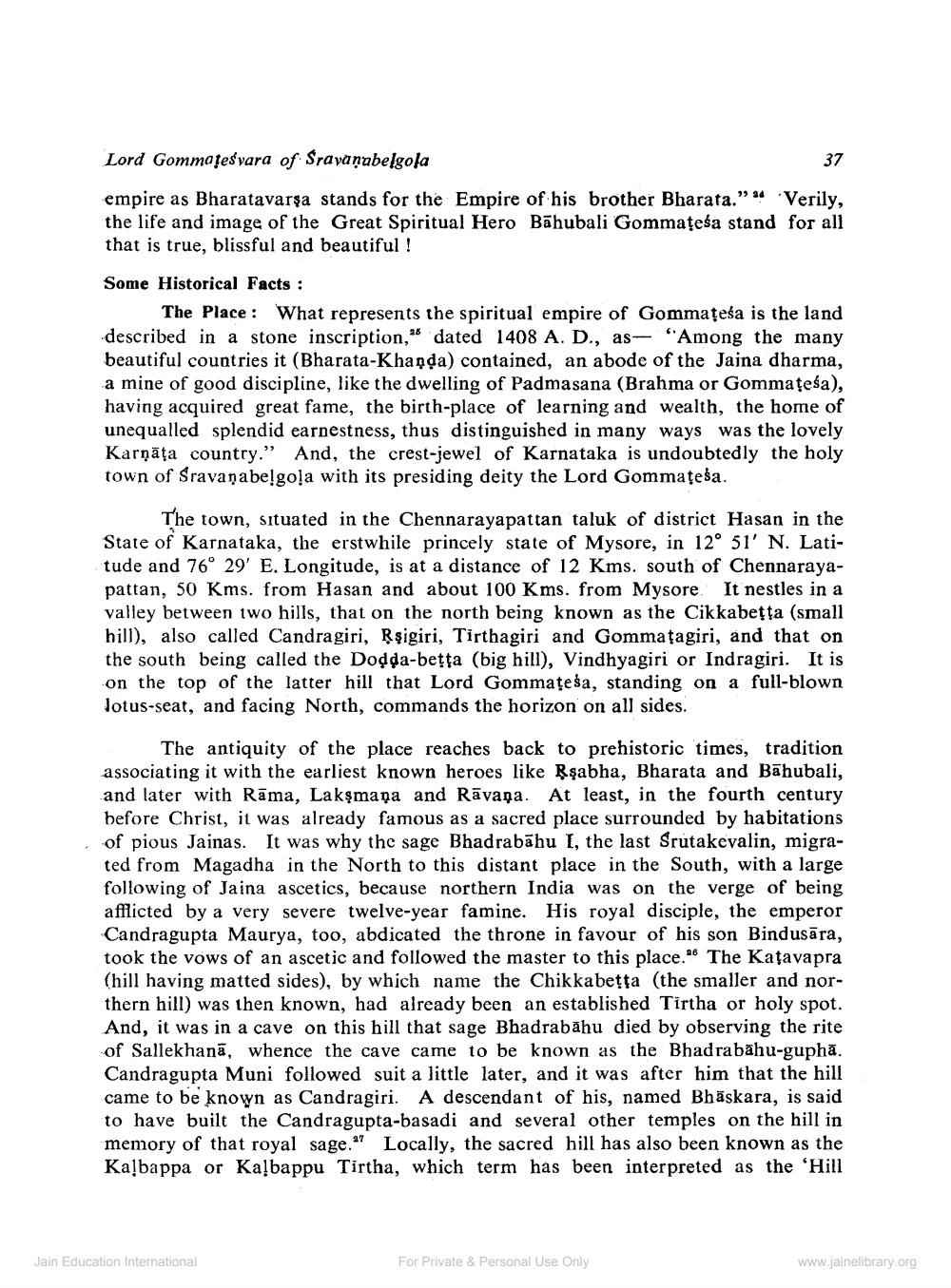________________
Lord Gomma ses vara of Srayaņabelgola
37
empire as Bharatavarşa stands for the Empire of his brother Bharata.”* Verily, the life and image of the Great Spiritual Hero Bahubali Gommateśa stand for all that is true, blissful and beautiful !
Some Historical Facts :
The Place: What represents the spiritual empire of Gommateśa is the land described in a stone inscription, as dated 1408 A. D., as- "Among the many beautiful countries it (Bharata-Khaqda) contained, an abode of the Jaina dharma, a mine of good discipline, like the dwelling of Padmasana (Brahma or Gommateśa), having acquired great fame, the birth-place of learning and wealth, the home of unequalled splendid earnestness, thus distinguished in many ways was the lovely Karņāța country.” And, the crest-jewel of Karnataka is undoubtedly the holy town of Sravanabelgola with its presiding deity the Lord Gommatesa.
The town, situated in the Chennarayapattan taluk of district Hasan in the State of Karnataka, the erstwhile princely state of Mysore, in 12° 51' N. Latitude and 76° 29' E. Longitude, is at a distance of 12 Kms. south of Chennarayapattan, 50 Kms. from Hasan and about 100 Kms. from Mysore. It nestles in a valley between two hills, that on the north being known as the Cikkabetta (small hill), also called Candragiri, Rşigiri, Tirthagiri and Gommațagiri, and that on the south being called the Dodda-betta (big hill), Vindhyagiri or Indragiri. It is on the top of the latter hill that Lord Gommatesa, standing on a full-blown Jotus-seat, and facing North, commands the horizon on all sides.
The antiquity of the place reaches back to prehistoric times, tradition associating it with the earliest known heroes like Rşabha, Bharata and Bāhubali, and later with Rāma, Lakşmaņa and Rāvana. At least, in the fourth century before Christ, it was already famous as a sacred place surrounded by habitations of pious Jainas. It was why the sage Bhadrabāhu I, the last Srutakevalin, migrated from Magadha in the North to this distant place in the South, with a large following of Jaina ascetics, because northern India was on the verge of being afflicted by a very severe twelve-year famine. His royal disciple, the emperor Candragupta Maurya, too, abdicated the throne in favour of his son Bindusāra, took the vows of an ascetic and followed the master to this place. The Katavapra (hill having matted sides), by which name the Chikkabetta (the smaller and northern hill) was then known, had already been an established Tirtha or holy spot. And, it was in a cave on this hill that sage Bhadrabāhu died by observing the rite of Sallekhanā, whence the cave came to be known as the Bhadrabāhu-guphā. Candragupta Muni followed suit a little later, and it was after him that the hill came to be known as Candragiri. A descendant of his, named Bhāskara, is said to have built the Candragupta-basadi and several other temples on the hill in memory of that royal sage." Locally, the sacred hill has also been known as the Kalbappa or Kaļbappu Tirtha, which term has been interpreted as the 'Hill
Jain Education International
For Private & Personal Use Only
www.jainelibrary.org




